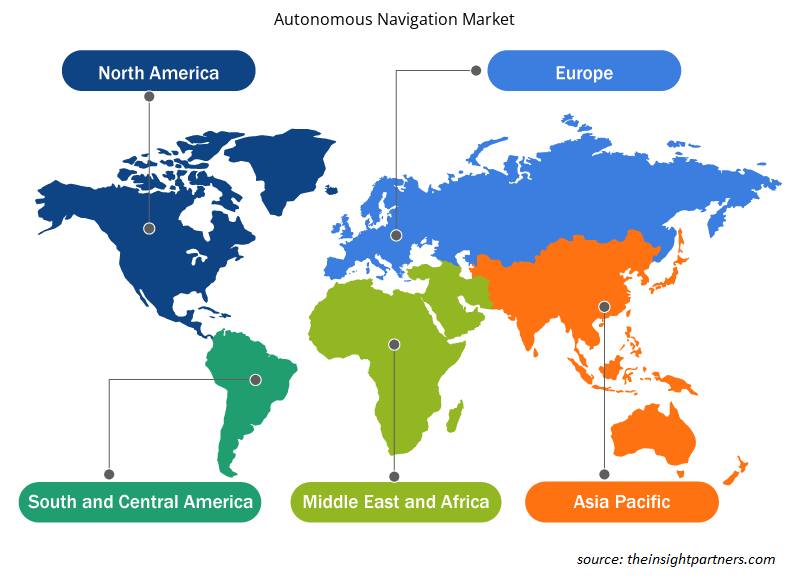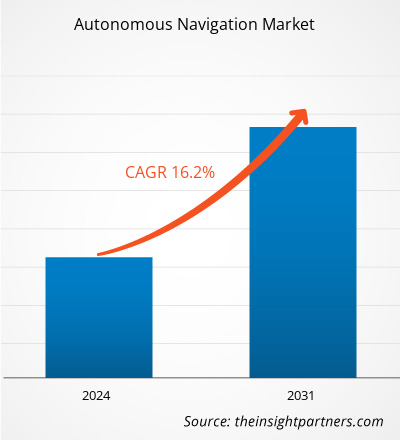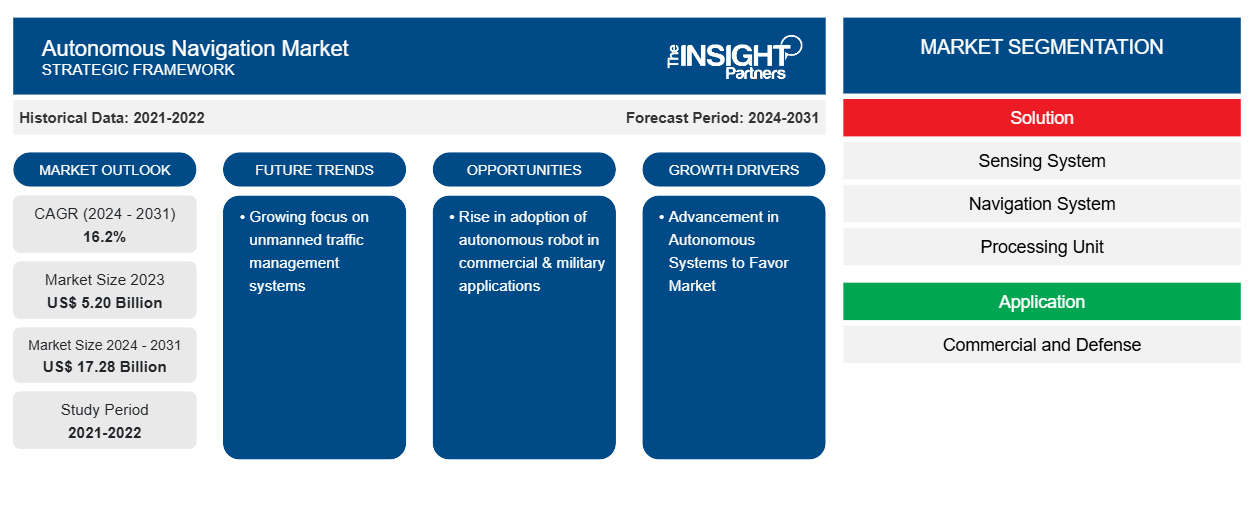La taille du marché mondial de la navigation autonome devrait passer de 5,20 milliards de dollars américains en 2023 à 17,28 milliards de dollars américains d'ici 2031 ; elle devrait croître à un TCAC de 16,2 % de 2024 à 2031. L'accent croissant mis sur les systèmes de gestion du trafic sans pilote devrait rester l'une des principales tendances du marché de la navigation autonome.
Analyse du marché de la navigation autonome
Les efforts continus pour faire progresser les systèmes autonomes ont été un moteur essentiel du secteur de la navigation autonome. Le développement de systèmes de navigation autonomes avancés pour diverses plateformes, notamment aériennes, terrestres, marines et spatiales, a contribué à stimuler l'expansion du marché.
Aperçu du marché de la navigation autonome
Un système de navigation autonome est une technologie complexe qui permet aux véhicules tels que les drones, les robots, les automobiles et les bateaux de planifier et d'exécuter leurs itinéraires sans intervention humaine. Ce système utilise une combinaison de technologies complexes, notamment la navigation inertielle, la navigation par satellite, les radars, les caméras, la navigation ultrasonique et acoustique , ainsi que des algorithmes puissants, pour prendre des décisions intelligentes en fonction de l'environnement. Grâce à cette technologie de pointe, le système de navigation autonome garantit que les voitures naviguent avec précision et en toute sécurité.
Personnalisez ce rapport en fonction de vos besoins
Vous bénéficierez d'une personnalisation gratuite de n'importe quel rapport, y compris de certaines parties de ce rapport, d'une analyse au niveau des pays, d'un pack de données Excel, ainsi que de superbes offres et réductions pour les start-ups et les universités.
- Obtenez les principales tendances clés du marché de ce rapport.Cet échantillon GRATUIT comprendra une analyse de données, allant des tendances du marché aux estimations et prévisions.
Moteurs et opportunités du marché de la navigation autonome
Les progrès des systèmes autonomes favorisent le marché
Les progrès technologiques et les études intensives ont contribué de manière significative à l'évolution des systèmes de navigation autonome. Ces progrès ont entraîné l'utilisation généralisée de véhicules autonomes, de drones et de systèmes robotisés dans divers secteurs, notamment les transports, la logistique, l'agriculture et la fabrication. Les avancées technologiques croissantes dans le secteur de la navigation autonome offrent diverses perspectives aux constructeurs de voitures autonomes. La proximité de grands marchés automobiles, tels que les États-Unis, ainsi que des accords commerciaux comme l'Accord de libre-échange nord-américain (ALENA), contribuent à stimuler l'expansion du secteur de la navigation autonome.
Augmentation de l'adoption de robots autonomes dans les applications commerciales et militaires
L’accessibilité, la rapidité du service et la fiabilité des plateformes de commerce électronique ont considérablement accéléré l’expansion du secteur du commerce électronique . Cette expansion peut être attribuée à diverses causes, notamment les avancées technologiques et la recherche et le développement continus dans les domaines de la robotique, de la vision par ordinateur, de l’intelligence artificielle et de l’informatique de pointe. Les robots autonomes jouent un rôle important dans les applications militaires. Ils sont utilisés dans diverses tâches de soutien au combat, notamment la guerre anti-sous-marine, la pose de mines, l’appui-feu, la guerre électronique, la gestion des dommages au combat, les missions de frappe, le ravitaillement en vol, etc. Ces robots aident les forces militaires du monde entier en remplaçant les éclaireurs humains et en effectuant des tâches trop risquées ou difficiles à accomplir pour les humains.
Analyse de segmentation du rapport sur le marché de la navigation autonome
Les segments clés qui ont contribué à l’élaboration de l’analyse du marché de la navigation autonome sont la solution, l’application, le type de véhicule et la plate-forme.
- En fonction de la solution, le marché est divisé en système de détection, système de navigation, unité de traitement et logiciel. Le segment des systèmes de détection détenait une part de marché plus importante en 2023.
- En termes d'application, le marché est divisé en deux segments : commercial et militaire. Le segment commercial détenait une part de marché plus importante en 2023.
- En fonction du type de véhicule, le marché est divisé en AGV, robots mobiles, UUV, drones et autres. Le segment des AGV détenait une part de marché plus importante en 2023.AGVs, Mobile Robots, UUVs, Drones, and Others. The AGVs segment held a larger market share in 2023.
- En fonction de la plateforme, le marché est divisé en segments terrestre, maritime et spatial. Le segment terrestre détenait une part de marché plus importante en 2023.
Analyse des parts de marché de la navigation autonome par zone géographique
La portée géographique du rapport sur le marché de la navigation autonome est principalement divisée en cinq régions : Amérique du Nord, Asie-Pacifique, Europe, Moyen-Orient et Afrique, et Amérique du Sud/Amérique du Sud et centrale. L’Amérique du Nord a dominé le marché de la navigation autonome en 2023. Cela est dû à la demande croissante de transport automatisé qui a été un moteur important du marché de la navigation autonome en Amérique du Nord. Alors que les industries et les consommateurs recherchent des solutions de transport plus efficaces et plus fiables, la demande de systèmes de navigation autonomes a augmenté.
Aperçu régional du marché de la navigation autonome
Les tendances régionales et les facteurs influençant le marché de la navigation autonome tout au long de la période de prévision ont été expliqués en détail par les analystes d’Insight Partners. Cette section traite également des segments et de la géographie du marché de la navigation autonome en Amérique du Nord, en Europe, en Asie-Pacifique, au Moyen-Orient et en Afrique, ainsi qu’en Amérique du Sud et en Amérique centrale.

- Obtenez les données régionales spécifiques au marché de la navigation autonome
Portée du rapport sur le marché de la navigation autonome
| Attribut de rapport | Détails |
|---|---|
| Taille du marché en 2023 | 5,20 milliards de dollars américains |
| Taille du marché d'ici 2031 | 17,28 milliards de dollars américains |
| Taux de croissance annuel composé mondial (2024-2031) | 16,2% |
| Données historiques | 2021-2022 |
| Période de prévision | 2024-2031 |
| Segments couverts | Par Solution
|
| Régions et pays couverts | Amérique du Nord
|
| Leaders du marché et profils d'entreprises clés |
|
Densité des acteurs du marché de la navigation autonome : comprendre son impact sur la dynamique des entreprises
Le marché de la navigation autonome connaît une croissance rapide, tirée par la demande croissante des utilisateurs finaux en raison de facteurs tels que l'évolution des préférences des consommateurs, les avancées technologiques et une plus grande sensibilisation aux avantages du produit. À mesure que la demande augmente, les entreprises élargissent leurs offres, innovent pour répondre aux besoins des consommateurs et capitalisent sur les tendances émergentes, ce qui alimente davantage la croissance du marché.
La densité des acteurs du marché fait référence à la répartition des entreprises ou des sociétés opérant sur un marché ou un secteur particulier. Elle indique le nombre de concurrents (acteurs du marché) présents sur un marché donné par rapport à sa taille ou à sa valeur marchande totale.
Les principales entreprises opérant sur le marché de la navigation autonome sont :
- BlueBotics SA
- YUJIN ROBOT Co., Ltd.
- KONGSBERG
- Trimble Inc.
- Robots ASI
- Collins Aérospatiale
Avis de non-responsabilité : les sociétés répertoriées ci-dessus ne sont pas classées dans un ordre particulier.

- Obtenez un aperçu des principaux acteurs du marché de la navigation autonome
Actualités et développements récents du marché de la navigation autonome
Le marché de la navigation autonome est évalué en collectant des données qualitatives et quantitatives issues de recherches primaires et secondaires, qui comprennent d'importantes publications d'entreprise, des données d'association et des bases de données. Voici une liste des évolutions du marché :
- En juin 2022, BlueBotics a lancé ANTdriven.com, une nouvelle ressource pédagogique destinée à aider les professionnels à démarrer leur parcours AGV (véhicule à guidage automatique). La plateforme fournit un contenu pédagogique clair et utile ainsi que des outils utiles et propose même des conseils d'experts gratuits. Elle est conçue pour aider les acheteurs potentiels à surmonter les défis et à trouver les véhicules automatisés les mieux adaptés à leur entreprise. ANTdriven.com propose une large gamme de contenus adaptés à chaque visiteur, quel que soit le stade de son parcours AGV.
(Source : BlueBotics, Communiqué de presse, 2022)
Rapport sur le marché de la navigation autonome : couverture et livrables
Le rapport « Taille et prévisions du marché de la navigation autonome (2021-2031) » fournit une analyse détaillée du marché couvrant les domaines ci-dessous :
- Taille du marché et prévisions aux niveaux mondial, régional et national pour tous les segments de marché clés couverts par le périmètre
- Dynamique du marché, comme les facteurs moteurs, les contraintes et les opportunités clés
- Principales tendances futures
- Analyse détaillée des cinq forces de PEST/Porter et SWOT
- Analyse du marché mondial et régional couvrant les principales tendances du marché, les principaux acteurs, les réglementations et les développements récents du marché
- Analyse du paysage industriel et de la concurrence couvrant la concentration du marché, l'analyse de la carte thermique, les principaux acteurs et les développements récents
- Profils d'entreprise détaillés
- Analyse historique (2 ans), année de base, prévision (7 ans) avec TCAC
- Analyse PEST et SWOT
- Taille du marché Valeur / Volume - Mondial, Régional, Pays
- Industrie et paysage concurrentiel
- Ensemble de données Excel
Rapports récents
Témoignages
Raison d'acheter
- Prise de décision éclairée
- Compréhension de la dynamique du marché
- Analyse concurrentielle
- Connaissances clients
- Prévisions de marché
- Atténuation des risques
- Planification stratégique
- Justification des investissements
- Identification des marchés émergents
- Amélioration des stratégies marketing
- Amélioration de l'efficacité opérationnelle
- Alignement sur les tendances réglementaires





















 Obtenez un échantillon gratuit pour - Marché de la navigation autonome
Obtenez un échantillon gratuit pour - Marché de la navigation autonome